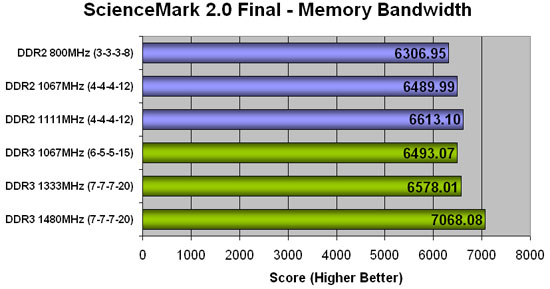Intel P35 Chipset: DDR2 Versus DDR3 Memory
Sciencemark and STALKER
ScienceMark 2.0 Final:
Science Mark 2.0 is an attempt to put
the truth behind benchmarking. In an attempt to model real world
demands and performance, ScienceMark 2.0 is a suite of high-performance
benchmarks that realistically stress system performance without
architectural bias. All of our testing was completed on the 32 Bit
Final benchmark version that is dated March 21st 2005.

Results: In Sciencemark 2 the memory bandwidth test showed the benefits by increasing clock frequency on both the DDR2 and DDR3 memory series. The DDR3 memory modules were unable to pull ahead with a FSB of 333MHz. With the FSB increased to 370MHz the DDR3 modules were able to show performance gains with the increased FSB and memory clock speeds.
S.T.A.L.K.E.R.: Shadow of Chernobyl
S.T.A.L.K.E.R.: Shadow of Chernobyl uses the ‘X-ray Engine’ to power the graphics. It is a DirectX 8/9 Shader Model 3.0 graphics engine. Up to a million polygons can be on-screen at any one time, which makes it one of the more impressive engines on the market today. The engine features HDR rendering, parallax and normal mapping, soft shadows, widescreen support, weather effects and day/night cycles. As with other engines that utilize deferred shading (such as Unreal Engine 3 and CryENGINE2), the X-ray Engine does not support anti-aliasing with dynamic lighting enabled. However, a “fake” form of anti-aliasing can be enabled with the static lighting option; this format utilizes a technique to blur the image to give the false impression of anti-aliasing. The game takes place in a thirty square kilometer area, and both the outside and inside of this area is rendered to the same amount of detail.

Results: At the default 1024×768 game resolution and settings we found that S.T.A.L.K.E.R.: Shadow of Chernobyl was more than playable on with both DDR2 and DDR3 memory modules on the P35 chipset. Less than a three frame per second difference was seen going from a DDR2 800MHz based system and a system running DDR3 at at staggering 1480MHz.


Comments are closed.